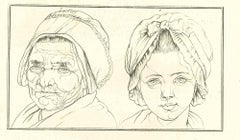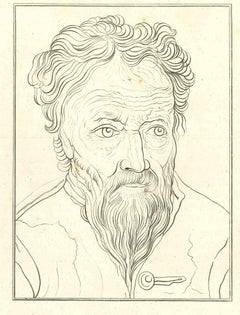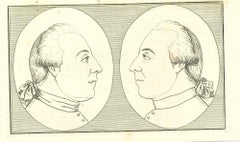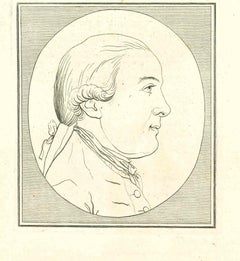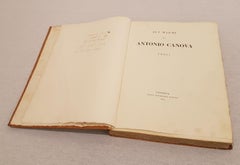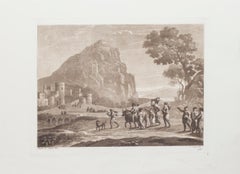1810s Art
to
70
512
29
26
6
4
Overall Width
to
Overall Height
to
7,514
21,276
158,185
232,596
1,958
2,277
4,878
6,417
5,802
13,181
19,509
25,573
18,142
13,466
5,371
269
153
1
1
320
243
11
481
216
215
207
187
125
101
96
71
55
50
32
20
13
12
11
11
10
10
10
496
90
47
32
22
309
15
15
3
3
41
478
165
37
Period: 1810s
Portrait - Original Etching by Thomas Holloway - 1810
Located in Roma, IT
Portraits is an artwork realized by Thomas Holloway (1748 - 1827).
Original Etching from J.C. Lavater's "Essays on Physiognomy, Designed to promote the Knowledge and the Love of Man...
Category
Old Masters 1810s Art
Materials
Etching
Portrait - Original Etching by Thomas Holloway - 1810
Located in Roma, IT
Portrait is an artwork realized by Thomas Holloway (1748 - 1827).
Original Etching from J.C. Lavater's "Essays on Physiognomy, Designed to promote the Knowledge and the Love of Mank...
Category
Old Masters 1810s Art
Materials
Etching
Portrait - Original Etching by Thomas Holloway - 1810
Located in Roma, IT
Portrait is an artwork realized by Thomas Holloway (1748 - 1827).
Original Etching from J.C. Lavater's "Essays on Physiognomy, Designed to promote the Knowledge and the Love of Mank...
Category
Old Masters 1810s Art
Materials
Etching
Portrait - Original Etching by Thomas Holloway - 1810
Located in Roma, IT
Portrait is an artwork realized by Thomas Holloway (1748 - 1827).
Original Etching from J.C. Lavater's "Essays on Physiognomy, Designed to promote the Knowledge and the Love of Mank...
Category
Old Masters 1810s Art
Materials
Etching
Sui Marmi di Antonio Canova - Ancient Illustrated Book - 1817
Located in Roma, IT
Rare and precious lifetime edition published by the Venetian publisher Picotti in 1817.
Pages: 223 + 17 not numbered.
In-4° with editorial binding and original "varies" paper "alla b...
Category
Modern 1810s Art
Materials
Paper
Landscape - Etching and Aquatint on Paper by L. Caracciolo After C. Lorrain
Located in Roma, IT
Landscape is an original etching and aquatint on paper realized by Claudio di Lorena.
Signed on the plate, on the lower left. plate no. 183, lower on the right, edition "L. Caraccio...
Category
1810s Art
Materials
Etching, Aquatint
Liber Veritatis - Original B/W Etching after Claude Lorrain - 1815
Located in Roma, IT
Image dimensions: 21 x 27 cm.
Liber Veritatis - Plate 145 is a beautiful black and white etching and aquatint on paper realized by the Italian artist Ludovico Caracciolo, after Clau...
Category
Old Masters 1810s Art
Materials
Etching, Aquatint
Customs of Civitacastellana - Etching by Bartolomeo Pinelli - 1819
Located in Roma, IT
Hand-watercolored Etching, 1819,
Image Dim: cm 28 x 20, Dim: cm 28x39.
Etching and Watercolor technique. In Good condition. Signed and dated on plate lower margin "Pinelli dis. e ...
Category
Realist 1810s Art
Materials
Etching
Liber Veritatis - B/W Etching after Claude Lorrain - 1815
Located in Roma, IT
Plate 23 – From Liber Veritatis
Aquatint on Copper, Imag. Dim: cm 33x47.5, Dim: cm 21x27,
Beautiful Artist’s Proof, representing a shepherd with his herd pastouring at the shore o...
Category
Old Masters 1810s Art
Materials
Etching, Aquatint
French Fashion: Lady and her Maid, a Drawing by Horace Vernet, 1814
Located in Philadelphia, PA
Horace Vernet
(French, 1789-1863)
Lady and Her Maid with a Dress, 1814
Watercolor on paper, 8 1/4 x 6 1/4 inches
Framed: 15 x 13 inches (approx.)
Signed and dated at lower right: "H...
Category
Realist 1810s Art
Materials
Paper
Design Fragment of St Albans Cathedral (1810), engraving by James Basire
Located in London, GB
James Basire & John Carter
Architectural Fragments of St Albans Cathedral
Engraving
62 x 46 cm
This engraving was originally published by the Society of Antiquaries of London, an...
Category
Realist 1810s Art
Materials
Engraving
Design fragments of St Albans Cathedral (1810), engraving by James Basire
Located in London, GB
James Basire & John Carter
Architectural Fragments of St Albans Cathedral
Engraving
62 x 46 cm
This engraving was originally published by the Society of Antiquaries of London, an...
Category
Realist 1810s Art
Materials
Engraving
Architectural Fragment of St Albans Cathedral (1810), engraving by James Basire
Located in London, GB
James Basire & John Carter
Architectural fragments of St Albans Cathedral
Engraving
62 x 46 cm
This engraving was originally published by the Society of Antiquaries of London, an...
Category
Realist 1810s Art
Materials
Engraving
Pensioner of Trinity Hall; Doctors in Law and Physic engraving by John Agar
Located in London, GB
To see our other Oxford and Cambridge pictures, including an extensive collection of works by Ackermann, scroll down to "More from this Seller" and below it click on "See all from th...
Category
Realist 1810s Art
Materials
Aquatint
Pensioner of Trinity Hall; Doctors in Law and Physic engraving by John Agar
Located in London, GB
To see our other Oxford and Cambridge pictures, including an extensive collection of works by Ackermann, scroll down to "More from this Seller" and below it click on "See all from th...
Category
Realist 1810s Art
Materials
Aquatint
Christ Church Cathedral, Oxford interior engraving by Bennett after Westall
Located in London, GB
To see our other Oxford and Cambridge pictures, including an extensive collection of works by Ackermann, scroll down to "More from this Seller" and below it click on "See all from th...
Category
Realist 1810s Art
Materials
Engraving, Aquatint
Peterhouse, Cambridge engraving by Stadler after Westall
Located in London, GB
To see our other Oxford and Cambridge pictures, including an extensive collection of works by Ackermann, scroll down to "More from this Seller" and below it click on "See all from th...
Category
Realist 1810s Art
Materials
Engraving, Aquatint
Kitchen of Trinity College, Cambridge engraving by Stadler after WH Pyne
Located in London, GB
To see our other Oxford and Cambridge pictures, including an extensive collection of works by Ackermann, scroll down to "More from this Seller" and below it click on "See all from th...
Category
Realist 1810s Art
Materials
Engraving, Aquatint
"Field Fare" and "Sea Fare" Pair by Benjamin Blake
Located in Mere, GB
"Field Fare" and "Sea Fare" Pair by Benjamin Blake. Benjamin Blake and his studio produced a number of fine quality larder scenes in the regency period. Bo...
Category
Realist 1810s Art
Materials
Oil
$4,026 Sale Price
20% Off
Chapel of Trinity College, Cambridge engraving by John Bluck for Ackermann
Located in London, GB
To see our other Oxford and Cambridge pictures, including an extensive collection of works by Ackermann, scroll down to "More from this Seller" and below it click on "See all from th...
Category
Realist 1810s Art
Materials
Aquatint
Crypt of St Peter's Church, Oxford engraving by Bluck after Nash for Ackermann
Located in London, GB
To see our other Oxford and Cambridge pictures, including an extensive collection of works by Ackermann, scroll down to "More from this Seller" and below it click on "See all from th...
Category
1810s Art
Materials
Aquatint
Chapel of Caius College, Cambridge engraving by Joseph Stadler for Ackermann
Located in London, GB
To see our other Oxford and Cambridge pictures, including an extensive collection of works by Ackermann, scroll down to "More from this Seller" and below it click on "See all from th...
Category
Realist 1810s Art
Materials
Aquatint
The Radcliffe Camera library Oxford engraving by John Bluck for Ackermann
Located in London, GB
To see our other Oxford and Cambridge pictures, including an extensive collection of works by Ackermann, scroll down to "More from this Seller" and below it click on "See all from th...
Category
Realist 1810s Art
Materials
Aquatint
Radcliffe Library, Oxford engraving by Hill after Mackenzie for Ackermann
Located in London, GB
To see our other Oxford and Cambridge pictures, including an extensive collection of works by Ackermann, scroll down to "More from this Seller" and below it click on "See all from th...
Category
Realist 1810s Art
Materials
Aquatint
Clare College, Cambridge / Clare Hall / King's College engraving by Stadler
Located in London, GB
To see our other Oxford and Cambridge pictures, including an extensive collection of works by Ackermann, scroll down to "More from this Seller" and below it click on "See all from th...
Category
Realist 1810s Art
Materials
Aquatint
MA Masters of Arts and Trinity College, Cambridge member engraving by John Agar
Located in London, GB
To see our other Oxford and Cambridge pictures, including an extensive collection of works by Ackermann, scroll down to "More from this Seller" and below it click on "See all from this Seller" - or send us a message if you cannot find the view you want.
John Samuel Agar (1773 - 1858) after John Uwins (1782 - 1857)
Pensioner of Trinity College, Cambridge, Masters of Arts, and Sizer (1815)
Hand-coloured aquatint
25 x 30 cm
Published by Rudolph Ackermann (1764 - 1834).
An engraving of a pensioner of Trinity College, Masters of Arts, and a sizer (that is, an undergraduate who received some form of assistance such as meals, lower fees or lodging during his period of study, in some cases in return for doing a defined job) from Ackermann's 'A History of the University of Cambridge, Its Colleges, Halls and Public Buildings'. The four figures walk forward with ceremonial accoutrements, possibly to a graduation ceremony.
At Cambridge, a sizar was originally an undergraduate student who financed his studies by undertaking more or less menial tasks within his college but, as time went on, was increasingly likely to receive small grants from the college. Certain colleges, including St John's and Trinity, distinguished between two categories of sizar: there were specific endowments for specific numbers of sizars who were called "proper sizars"; those who were not so endowed, but who were maintained by fellow-commoners and fellows were called subsizars. Isaac Newton matriculated as subsizar at Trinity College. Richard S. Westfall noted that sizars were considerably more successful in gaining degrees than the gentlemen who entered Cambridge in the seventeenth century. Pensioners, on the other hand, paid a fixed annual fee in order to study.
Thomas Uwins RA RWS was a British painter in watercolour and oil, and a book illustrator. He became a full member of the Old Watercolour Society and a Royal Academician, and held a number of high-profile art appointments including the librarian of the Royal Academy, Surveyor of Pictures to Queen Victoria and the Keeper of the National Gallery. In the late 1790s he began producing work for Ackermann's collections.
John Samuel Agar was an English portrait painter and engraver, who exhibited his works at the Royal Academy from 1796 to 1806 and at the British Institution until 1811. He was at one time president of the Society of Engravers. Rudolph Ackermann published many of his engravings.
Ackermann was an Anglo-German bookseller, inventor, lithographer, publisher and businessman. He attended the Latin school in Stollberg, but his wish to study at the university was made impossible by lack of financial means, and he therefore became a saddler like his father.
He worked as a saddler and coach-builder in different German cities, moved from Dresden to Basel and Paris, and then, 23 years old, settled in London. He established himself in Long Acre, the centre of coach-making in London and close to the market at Covent Garden.
Ackermann then moved to Little Russell Street where he published Imitations of Drawings of Fashionable Carriages (1791) to promote his coach-making. Other publications followed. In 1795 he established a print-shop and drawing-school at 96 Strand. Here Ackermann set up a lithographic press and began a trade in prints. He later began to manufacture colours and thick carton paper for landscape and miniature painters. Within three years the premises had become too small and he moved to 101 Strand, in his own words "four doors nearer to Somerset House", the seat of the Royal Academy of Arts.
Between 1797 and 1800 Ackermann rapidly developed his print and book publishing business, encompassing many different genres including topography, caricature, portraits, transparencies and decorative prints.
During the Napoleonic wars, Ackermann was an energetic supporter of the Allied cause and made significant contributions to British propaganda through his publication of anti-Napoleonic prints...
Category
1810s Art
Materials
Aquatint
Portrait of Madame Leblond
Located in BELEYMAS, FR
French school circa 1815
Portrait of Madame Leblond
Oil on canvas
H. 66 cm; W. 55 cm
Named on the back
Comparable to the works of painters such as Louis Hersent, our portrait, unsig...
Category
French School 1810s Art
Materials
Canvas, Oil
19th century landscape of rome daily life by fine print master Sir Muirhead Bone
Located in Milan, IT
Original etching and drypoint, signed in the plate and in pencil in the lower right corner; Dodgson "Etchings and drypoints by Muirhead Bone", Print Collector's Quarterly, 1922, IX, p. 173-200; Mackenzie, British Prints, p. 57; 400 x 278 mm
Superb test with signs particularly rich in beards, a characteristic typical only of the first tests: the pictorial effect is very effective. Small uneven margins. In perfect state of conservation.
Rich of burr drypoint, 1916, printed on cream paper. Good margins all around. In good condition.
Sir Muirhead Bone (23 March 1876 - 21 October 1953) was a Scottish etcher and watercolorist who became known for his depiction of industrial and architectural subjects and his work as a war artist in both the First and Second World Wars. Bone was an active member of both the British War Memorials Committee in the First World War and the War Artists...
Category
English School 1810s Art
Materials
Etching
Monastery of St. Augustine, Canterbury /// William Dugdale Monasticon Anglicanum
Located in Saint Augustine, FL
Artist: Sir William Dugdale (English, 1605-1686)
Title: "Monastery of St. Augustine, Canterbury"
Portfolio: Monasticon Anglicanum: A History of the Abbies and Other Monasteries, Hosp...
Category
Old Masters 1810s Art
Materials
Engraving
Whitehaven, Cumbria engraving by Elizabeth Byrne after Joseph Farington RA
Located in London, GB
To see more, scroll down to "More from this Seller" and below it click on "See all from this Seller."
Elizabeth Byrne (1777 - 1849) after Joseph Farington RA (1747 - 1821)
North View of Whitehaven, Cumbria
Hand-coloured engraving
27.5 x 56.5 cm
A view of the cliffs and port of Whitehaven in Cumbria.
Joseph Farington RA was an 18th-century English landscape painter and diarist. He drew a north and south view of Whitehaven, which were engraved by Elizabeth Byrne in the early 19th century. Byrne was a London-born etcher and landscape painter, who was taught by her father, the etcher William Byrne...
Category
Realist 1810s Art
Materials
Engraving
Robert Woodlark, St Catharine's College, Cambridge founder engravings
Located in London, GB
To see our other Oxford and Cambridge pictures, including an extensive collection of works by Ackermann, scroll down to "More from this Seller" and below it click on "See all from this Seller" - or send us a message if you cannot find the view you want.
Robert Woodlark Founder of Catherine Hall, Cambridge from a Picture at the Hall (1815)
Hand-coloured aquatint
24 x 20 cm
Published by Rudolph Ackermann (1764 - 1834).
A copy of this engraving is held by the National Portrait Gallery, reference NPG D4871.
Robert Woodlark (also spelled Wodelarke) was an English academic and priest. He was the Provost of King's College, Cambridge, and the founder of St Catharine's College, Cambridge. He drew up the original statutes for the governance of the college and obtained a charter from Edward IV...
Category
Realist 1810s Art
Materials
Aquatint
Westminster Abbey South Aisle engraving by John Bluck for Ackermann
Located in London, GB
To see our other Oxford and Cambridge pictures, including an extensive collection of works by Ackermann, scroll down to "More from this Seller" and below it click on "See all from this Seller" - or send us a message if you cannot find the view you want.
John Bluck (early 19th century) after Frederick Mackenzie (1788 - 1854)
East End of South Aisle, Westminster Abbey (1812)
Hand-coloured aquatint
31 x 24 cm
Published by Rudolph Ackermann...
Category
Realist 1810s Art
Materials
Aquatint
French Fashion: Two Ladies, a drawing by Horace Vernet, 1814
Located in Philadelphia, PA
Horace Vernet
(French, 1789-1863)
Two Ladies Standing, 1814
Watercolor on paper, 8 x 6 1/4 inches
Framed: 15 x 13 inches (approx.)
Signed and dated at lower right: "H.Vernet--1814."...
Category
Realist 1810s Art
Materials
Paper, Watercolor, Pencil
Pair of French Neoclassical oil paintings by Dubost
By Antoine Dubost
Located in London, GB
Pair of French Neoclassical oil paintings by Dubost
French, 1809/11
Frame: Height 70.5cm, width 86cm, depth 9cm
Panel: Height 45cm, width 61c...
Category
Baroque 1810s Art
Materials
Oil, Panel
$17,139 Sale Price
30% Off
Pastoral Drawing of a Young Man Resting by the Roadside
Located in Philadelphia, PA
Jacques-Laurent Agasse
(Swiss, 1767-1849)
Young Man Resting by the Roadside, 1819
Pen and ink and wash on paper, 5 1/4 x 6 1/2 inches
Framed: 13 x 11 3/4 inches (approx.)
Signed and ...
Category
Realist 1810s Art
Materials
Paper, Ink, Pen
"A Peep Into The Pump Room Or The Zomersetshire Folk In A Maze" 1818
Located in Bristol, CT
Print Sz: 10"H x 14 1/2"W
Frame Sz: 16"H x 20"W
Artist: Fores, S.W.
The people are striving to see Queen Charlotte, who visited Bath to take the waters in November 1817. The Duke ...
Category
1810s Art
Materials
Lithograph
Moroccan, Fez or Meknes: Tall bowl (Jobbana) with geometric designs
Located in New York, NY
Provenance:
Collection of Emily Johnston De Forest and Robert Weeks De Forest, New York, by 1911-until 1942; thence by descent until 2018.
Literature: ...
Category
1810s Art
Materials
Earthenware, Tin Glaze
"Smuggling In High Life" c1814 Colour Engraving By W N Jones
Located in Bristol, CT
Art Sz: 10"H x 16"W
Frame Sz: 15 1/2"H x 21"W
Pub, January 1st 1814
Property from the Estate of Paula Peyraud
A reserved librarian from Chappaqua, New York, Miss Paula Peyraud wa...
Category
1810s Art
Materials
Paper
